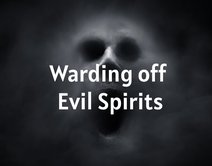Malevolent forces have been feared by human beings for as long as anybody can remember. It is believed that evil spirits are to blame for inclement weather, illness, death, all forms of suffering, and anything that goes wrong. Some people believe that a head evil spirit drives misfortune, and others think evil spirits are not necessarily organized, but are still to be feared. People go to great trouble to do religious and magical workings to try to ward off evil spirits to keep them from causing harm. Different belief systems teach different things about malevolent spirits and how much damage they can cause. This article will explore beliefs about evil spirits and how to ward them off from different religious traditions.
Christian
Christianity is believed to date back to the date of the crucifixion of Jesus Christ and if that is true, the religion is close to 2,000 years old. It is practiced on every continent and is one of the two largest religions on earth with over 2 billion adherents, or close to ¼ of the entire population worldwide. There is no one unified belief system about evil spirits that all Christians all through time have embraced. There is belief in a devil most Christians adhere to, but Catholics, Voduns, and Ceremonial Magicians have some specific beliefs about evil spirits
Catholics

Catholics traditionally believe that the devil is the source of all evil and the ruler of all evil spirits, which they call demons. It is believed their god created the devil, called Satan, as a good angel to serve him, but Satan and other angels rebelled against god, and are now evil. They believe that Satan and his devils tempt human beings away from their god, and those who follow the lead of Satan will go to hell when they die. Catholiceducation.org writes, “ Our Lord identified Satan in various ways. He called Satan the Prince of this World: Satan uses material things to distract us from God. He tempts us to adore the material, the sensual, and the powerful rather than to adores (sic) God. He lures us into a sense of false security of thinking we can build our own little kingdom here and now without any need of God.
Jesus referred to Satan as the Father of Lies: The devil perverts the truth, as he did with Eve. He fills our minds with doubts. He provides all the rationalizations why something is right even though our Lord and the Church teach it is wrong.
Satan is the Prince of Darkness: He lurks about and is crafty. He fills us with the pessimistic thoughts, the bad thoughts, the hateful thoughts. He shows us all the hurts, frustration and troubles of this world and of our own lives hoping to lead us to despair.
Finally, Jesus called him the Murderer: The devil seeks to kill the grace of God in our soul, and then take our soul to hell. “The Devil, the Fallen Angel
The way Catholics keep evil spirits away is through baptism and prayer. It is believed that if you are baptized, the devil and demons can tempt you, but they cannot possess your body. It is believed that you can still go to hell for eternity even if you have been baptized, but the sacrament of confession is believed to cleanse your spirit and you can go to heaven if you confess and repent from all sins before death. It is believed by Catholics that those who have not been baptized can suffer from demonic possession, meaning evil spirits or the devil himself can reside in their body. However, the Catholic Church has a solution for that, and it is exorcism, or casting out of the evil spirits, which some Priests have been trained to do.
Exorcism is defined by The United States Conference of Catholic Bishops Exorcism | USCCB as “ A specific form of prayer that the Church used against the power of the devil.” They list exorcism into two types. The first type of exorcism is prayers used before baptism for children and adults and the second form of exorcism is more involved and is used to expel demons from somebody. Not just anybody gets an exorcism to expel demons in modern times, and psychological evaluations that disease does not account for strange behavior are conducted before a major exorcism is approved. Then , only specially trained Priests are permitted to do the exorcism, and it is believed by Catholics that an exorcism is 100% effective.
Voodoo
Voodoo is a combination of traditional African religions and Catholicism, and it was created by African slaves in America. It has roots in West African traditional faiths called Vodun, and similar faiths were created in Haiti, Cuba, the Dominican Republic, and Brazil. In New Orleans, Haitian Voodoo combined with Catholicism and traditional African beliefs. Louisiana Voodoo adherents believe in the devil and the evil that human beings do to one another. It is very dangerous to anger somebody who knows how to do magic and cast spells, and protection against the devil and curses people do are done.
It is believed the ancestors and protective loa, or spirits have personal relationships with people, and communication with these good spirits is a big part of Voodoo. These spirits will also protect people, and relationships with them are maintained properly, lest they become angry and punish people. Gris gris, or blessed items are carried to ward off negative entities. These originated in Africa, and are often small cloth bags or bundles filled with auspicious things and they may have sacred writing on them as well. These are used by people who adhere to this faith and by some who don’t, and these are placed on buildings for protection as well. Gris gris can be used to do malevolent magic also and if you are not careful, your protective gris gris can be destroyed by somebody who does not want you to be protected.
The Gullah of the Sea Island and Lowcountry region of the United States are another group whose beliefs combine Christianity and African beliefs, and they paint their porches various light shades of blue or aquamarine which they call “haint blue”. This is believed to keep ghosts away from the house. The blue is believed to either look like the sky, which malevolent ghosts have no interest in, or water, which it is believed the ghosts cannot cross. The porch, doorways, and windowsills can be painted in this color. Another way to ward off malevolence is to counteract curses. Some people in Voodoo place substances on people’s doorsteps to curse them and to counteract this, all you have to do is sprinkle brick dust, or clean your doorstep.
Ceremonial Magic
Although not specifically considered a Christian denomination, Abrahamic religious beliefs and rituals were heavily relied upon to create Ceremonial Magic rituals. A Ceremonial Magician may practice any religion, or be an agnostic or atheist, but he or she will still be using ancient practices from Abrahamic mysticism in their ritual practice. A concept that few other belief systems embrace is that an individual human being can command all forms of spirits be they malevolent or benevolent spirits. While most faith adherents will say prayers and avoid evil spirits or call upon their clergy to ward off evil, Ceremonial Magicians conjure and call any spirit they feel they can handle.
Distinct instructions for doing so are spelled out in The Lesser Key of Solomon. This book was believed to be written by King Solomon, who was believed to rule ancient Israel and Judah in the 900’s BCE. The Lesser Key of Solomon is a magical textbook, or grimoire about demons. This publication is more likely inspired by European grimoires from as early as the 1300’s. The book was translated by Samuel Liddell and MacGregor Mathers and edited and published by Aleister Crowley in 1904 with the title of The Goetia of Solomon the King. Crowley added some of his own writings to this.
72 demons are paired with angels, who are supposed to bind the demons from harming a Ceremonial Magician who would conjure them. The Magician creates amulets with the individual seals, or magical symbols of each demon to use when working with them. Specific instructions for setting up the magical ritual space are given, and also included is specific instructions for conjuring said demons. It is believed by the Magicians that if they are powerful enough, the demons will obey them, and not harm them. Various demons can be called upon for help with things like understanding mathematics, changing wine to water or water into wine, or foretelling the future. Ceremonial Magicians are not afraid of these entities and believe that if they do the magic and rituals properly, no harm will befall them.
Traditional Japanese
Hannya, Oni, and Yokai are just a few of the words used in Japan to describe different types of demons or malevolent spirits. Interestingly, these spirits are not all bad, and can be helpful to humans , sometimes being protective. These beings have been represented in classical art and theater productions and are famous worldwide due to the beautiful artistic ways in which they are portrayed. Different beings are believed to have different characteristics, and the way to keep them from harming varies as well.
Oni and Yokai

Oni are living beings who live on earth. They usually have red, black, or blue skin or some other terrifying physical appearance and they possess superior strength. They usually have horns and wear nearly no clothing, oftentimes only a loincloth. They have tusk like fangs and claws and are often seen carrying heavy clubs they use to maim human beings. They are associated with disease, misfortune, and are often out doing villainous deeds. Another demon is the yokai, which are spirits who might be malevolent or benevolent to people. The yokai can have a human-like appearance or have no tangible shape at all. Some yokai are out to cause trouble and other times the word yokai just refers to unexplainable phenomenon.
Hannya
The hannya is a different being altogether, however. A hannya is created when a living human woman becomes so driven to rage based on her jealousy, she turns into a malevolent being while she is still alive. Once she dies, she becomes an onryo, or vengeful spirit. This being is similar to the Buddhist hungry ghost. Hungry ghosts either had traumatic deaths or are not venerated properly by their descendants or. One can also become a hungry ghost through living a wicked life or sins they had not repented from.
All of these beings could cause great problems for people. The oni can be killed by a swordsman if they cause too much trouble, but demons and ghosts were thought of as more difficult to handle. Hannyas can be handled with Buddhist prayers, and some of them are so consumed by their jealousy, they cannot be appeased. The yokai can be dealt with in various ways. One was a poisonous serpent being who was terrifying people, but it was venerated as a god, and became a water spirit of protection. Others are slain by Shoki, who defeats demons and evil spirits and sometimes commands them to do good deeds.
Islamic

Islam is one of the three religions that the prophet Abraham is credited with being responsible for. Like Christians, Muslims worship one god, and they do believe in a being of evil. However, he is not named Satan, he is named Iblis and Muslims believe in beings called the djinn.
Iblis
Iblis was a djinn, who was conceived by Allah from the smokeless flame, and he was a high ranking angel. He was considered pure and perfect. Allah was displeased with the first people on earth, and wiped them out, replacing them with Adam and new humans who he formed out of clay. He was so pleased with this creation, he ordered all the angels to bow to Adam, but Iblis refused. He said he would not prostrate himself to a creature formed from dirt and that he bowed only to Allah. For this Allah cast him out of heaven. Iblis was so upset by this he vowed to spend all his time tempting human beings away from Allah.
Some think of Iblis as a Shaytan, or tempter, and others consider him the first true monotheist whose devotion to Allah was so strong he would not even bow to another being. There is much debate about the true nature of Iblis. Some say he could not have been an angel because angels do not have free will and an angel could not disobey Allah. Others argue the Quran did not specify that Iblis was created from smokeless fire and could therefore not have truly been a djinn. The facts were, however, that when the angels were ordered to bow, Iblis refused, and he was cast from heaven. Sometime later Allah actually granted Iblis permission to tempt people, but there was a catch. The true followers of Allah would be unable to be tempted.
Djinn
Folklore presents multiple possibilities about the djinn. They are lower than gods but had at one time been worshiped as such. It appears the difference between djinn and gods was that the gods were immortal and the djinn were not. Also, the djinn were privately worshiped whereas gods were publicly worshiped. It is possible these were pre-Islamic spiritual beings who were transformed in folklore for Islam to be included. Djinn were stronger than humans but could be killed by people. They could help or harm people, and some djinn even married people.
The Quran forbade the pre-Islamic practice of worshiping djinn for protection and it was written that the Prophet Muhammad sent his disciples among both people and the djinn. So, the exact origin and nature of the djinn since the dawn of time is not easy to define, but over time, they became the fallen spirits cast out by Allah and those who followed Iblis. Djinn were said to rule the earth before humans and to eat rotted flesh instead of food. Some djinn could fly, some were four legged animals, and some behaved like humans. Some even say the djinn are invisible and others were known to steal things or kidnap children and they could even spiritually possess people.
Warding Them Off
Nobody wants to be around beings that kidnap children or go out of their way to come between humanity and their creator. One thing was agreed upon among the varying beliefs, and that was that Iblis and the djinn could harm who they pleased, and people should be wary of them. Djinn would not possess just anybody but would target people who fell into states of despair, so this feeling can be avoided to ward off the djinn. Others say a djinn cannot possess people, but only whisper temptations, so the way to ward them off is by refusing their temptation. Duas, or prayers to call out for Allah’s help can also be used to protect against all evil.
One dua is “ My Lord! I seek refuge with you from the whisperings (suggestions ) of the Shayatins (devils.) And I seek refuge with you my Lord! Lest they may attend (or come near) me. “ Another is “I seek refuge in the perfect words of Allah from the evil of what he has created.” It is believed Iblis and his followers seek to instill pridefulness and rebelliousness in humanity to separate them from Allah. All people have to do is to ignore the temptation. You must have faith in Allah, and you must fear Allah instead of Iblis or the djinn. It is believed that these things will ward their evil intentions off.
Celtic
The Celts were a people who were from parts of Europe and Asia Minor who shared culture and languages. People such as the Gaels and Boii were organized into tribal groups. Experts are not positive exactly where the celts first originated, but the first Celtic language in writing that is currently known is from the 6th century BCE, so we know they have been around for at least that long. There was not just one group of Celts and no one unified belief system. Furthermore, we don’t know exactly what early Celts believed about evil spirits. There is evidence they did animal sacrifices to their gods, and this could have been done to either give thanks or to ask for abundant harvests.
Feeding the Sun
They were known to believe that human beings could help to empower the sun. Bonfires were lit during auspicious times of year to emulate the warmth and light of the sun, and these burned day and night for days at a time during some events. Keeping the sun strong would ward off the malevolence of starvation because without the sun, no crops would grow to feed the people. The most sacred times of year for some groups of Celts were Beltane on May 1, Lughnasa on August 1, Samhain on November 1, and Imbolc on February 1. At Samhain in particular, it was believed the dead would walk the earth and kidnap the living to take them back to the land of the dead if they wanted to. To prevent this, people would carry a piece of iron for protection, wear their clothing inside out, or wear costumes to disguise themselves as supernatural spirits so they would be ignored.
Healing
Votive offerings for healing were left and it is possible it was given as a way of discarding a representation of the body part that needed to be healed. This could have been done in hopes that whatever malevolent spirit was attacking that part of the body would attack the votive instead. Visits to clootie wells, or healing wells are done by the descendants of the ancient Celts to this day. Gifts are tied to trees as well as prayers for healing. A rag is dipped in what are believed to be healing waters, and the affected body part is washed with the water. The rag is tied to the tree, and it is believed that as the rag decomposes, the ailment will disappear. Some people leave nice new cloth as offerings at the clootie wells instead of washing the afflicted areas of the body and gifts like rosaries or other religious medallions are left. The pilgrimage to these healing wells is popular during the four sacred days ancient Celts observed and asking spirit beings to remove illness counts as a way of warding off malevolence, or disease.
Ancient Mesopotamia
Mesopotamia occupied modern day Iraq, parts of Syria, Kuwait, Turkey, and Iran. It was where Babylonians, the Assyrians, Sumerians, and Akkadians were. It was where important parts of the Neolithic Revolution took place, around 10,000 BCE. This included the development of cursive writing, planting the first cereal crops, the invention of the wheel, and other technological advancements. Mesopotamia is known by some as the cradle of civilization. Even their religions influenced other cultures of people in ways we may never fully appreciate. Their religion is the first recorded that we know of and like most people, they believed in malevolent spirits.
Their definition of sin was something that angered their gods, and sin was punished with misfortune. Natural disasters and war were considered a punishment from the gods, and people could even anger the gods, and not know it. It was the responsibility of kings, who may have also been head priests, to appease the gods and help the people. The Mesopotamians worshiped over 2,000 different gods and goddesses. Their religious stories most likely influenced the story of the great flood, the creation, the Garden of Eden, and other stories picked up by Jews and later, Christians and Muslims. Mesopotamians also had malevolent spirits. A few of them were Pazuzu, Lamashtu, and Gallus. Unlike the devil, some of the Mesopotamian demons were called upon for help, and they could aid humans in their time of need.
Pazuzu
This demon had rulership over a class of demons called lilus and he was the southwest wind. Lilus were wandering spirits who caused harm to human beings. It was believed Pazuzu wandered with the wind , and that he brought drought and famine. However, despite the fact he could bring things like famine and damage from wild winds, he tamed the other wind demons, breaking their wings when he wanted to keep them from causing harm. He was also called upon to protect from plague. He was the enemy of the terrifying Lamashtu, and he was protective of mothers in childbirth who she sought to harm. He was asked to protect the household and people wore amulets with his image and placed images of him in their home for protection. He was a god and a demon all in one and was both feared and called upon for help.
Lamashtu
This was a demoness who was also a goddess, and she would cause miscarriages and terrorize women in childbirth, sometimes kidnapping babies as their mothers breastfeed them. She harmed or killed children as well as adults. She disturbed sleep and brought nightmares. Lamashtu poisoned fresh water, destroyed crops, and created sickness and death. Pazuzu may have been created to battle her, and coins depict him chasing her to the underworld where she could not harm anybody. She was simply a malevolent entity who acted for her own satisfaction and she was seen as especially evil because she did not create destruction to bring justice. However, she was called upon for protection despite her malevolence, and it was believed her strength and ferocity could protect anybody who wore an amulet with her name on it.
Gallu
The gallu were seven demons who were in the underworld. They worked for the goddess Ereshkigal and were demons who pursued the goddess Inanna when she was delivered from the underworld by the gods. Asag was one of them who was said to be so grotesque, the very sight of him made fish boil alive in the waters. He fathered children with a mountain, and they were rock demons who accompanied him in battle. The gallu were tasked with dragging souls to the underworld and while these were especially horrid spirits, they, too, could be benevolent to people. Simply leaving offerings on the altar for them would appease them.
Perhaps our belief in evil spirits is our way of explaining natural phenomena. We don’t want to believe that the world created by a loving deity could be toxic to life. So, we tell ourselves a storm is caused by a demon and death is brought on by evil spirits. Maybe we are afraid we don’t deserve the sun to rise and shine and we think we have to earn it. So, we pray to a sun god and we give offerings and strength to the sun that it may shine so food can grow and nourish us. Perhaps we characterize natural things as being driven by living forces instead of seeing them scientifically. Maybe these things are created by spirits and deities, and human beings are necessary to make sure the world continues to thrive after all. Maybe spirits really do cause all the misfortunes and suffering all beings are burdened with. Maybe our rituals, prayers, and taboos really do serve to help ward off the evil spirits that cause all that suffering. Different people throughout history have had different ideas of how it is best to ward off evil and prevent suffering.
All of these different beliefs from so many people share something in common. These people all believed there were malevolent forces at work in the world and they believed there was something human beings could do about it to protect themselves. Maybe you are not afraid of demons, but the thought of illness worries you. Maybe you are not concerned about disease, but you care deeply about your relationship with the deity you worship as your mother goddess or father god. Everybody wants to know ways to protect themselves against what they believe is wickedness, but not everybody follows a religion.
You can create your own sacred practice, and if you don’t know where to start, simply light a candle and say a prayer for guidance and then listen. The sacred voice in your heart will speak and tell you what you need. May you live your scared truth and live it so well that no evil can touch you. So Be It.
We have selected the most relevant psychics for this article, you can connect with any of them and get accurate advice on this subject.









